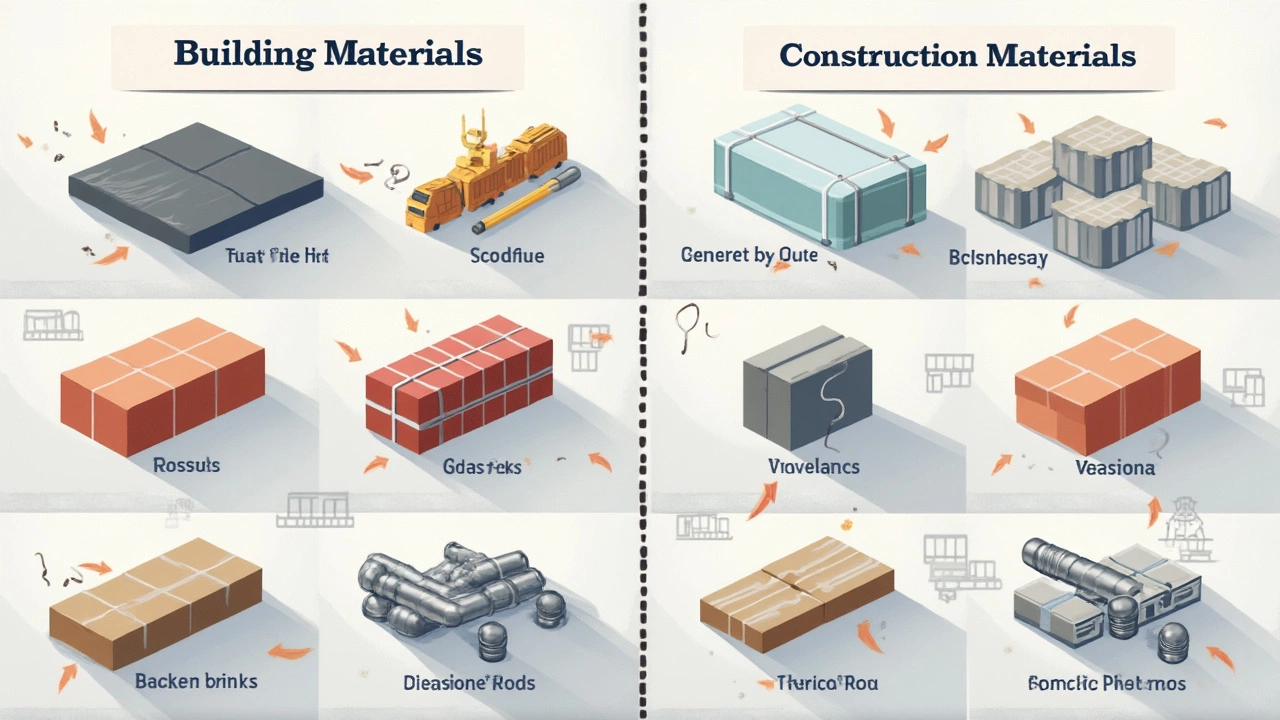Ever wonder if there’s any real difference between building materials and construction materials, or are they just two names for the same thing? You’re not alone—this mix-up trips up a lot of folks, even experienced builders sometimes. Getting the terms right can actually save you money and headaches when it’s time to order supplies or talk with contractors.
Think about how annoying it is when someone asks for a "building material" and you’re in the concrete section, only to find out they wanted electrical wire. Misunderstandings like that can mess up your timeline or even lead to expensive returns. Let’s break down what makes these two terms different (yes, there’s more to it than you think), so you always know what you’re asking for or getting billed for.
- Why the Terms Matter
- Basic Definitions Explained
- Everyday Examples You’ll Recognize
- How Professionals Use These Terms
- Tips for Picking the Right Materials
- Common Misconceptions to Watch Out For
Why the Terms Matter
Getting the difference between building materials and construction materials right isn’t just about sounding smart—it can actually save time and cash on a project. Builders, suppliers, and clients all toss these phrases around, but if they’re not on the same page, you end up with mix-ups, wasted supplies, or even project delays. Clarity keeps jobs running smoother, cuts mistakes, and helps keep everyone in sync.
Here’s the thing: when you order stuff using the wrong term, you might get the wrong product entirely. For example, ask for construction materials and you might end up with gear for things way beyond what you need—think scaffolding or protective equipment instead of just wood and bricks.
Ever worked on a jobsite where delays sent the budget off track? According to a 2023 construction survey, 24% of project overruns were blamed on “materials confusion” between buyers, suppliers, and the folks actually doing the work. That's straight-up money lost just from not clarifying terms at the start.
| Problem | Impact |
|---|---|
| Wrong material delivered | Work stoppage, returns needed |
| Supply ordering errors | Extra costs, blown budgets |
| Miscommunication with suppliers | Delays, disputes |
Clear talk means better results. Knowing whether you need a construction material (like rebar or concrete forms) or a building material (like bricks or timber) is what helps the right stuff show up on time, every single time.
Basic Definitions Explained
Let’s clear up the basics. Building materials usually mean the physical stuff you use to create the actual structure of a building. We’re talking about things like wood for framing, bricks for walls, cement for the foundation, steel for beams, and roof tiles. These are the bones and skin of any house, office, or warehouse. If you see a pallet of bricks or a stack of plywood, that’s classic building materials.
Construction materials is the bigger, umbrella term. It covers all building materials, but also throws in everything else needed to assemble, finish, and outfit a project. Think insulation, electrical wiring, drywall, pipes, adhesives, rebar, glass, and even stuff like sealant tape. If it gets stuck, nailed, poured, or wrapped anywhere on a job site, it’s a construction material. So, every building material is a construction material, but not every construction material is a building material.
Here’s a quick breakdown so you can spot the difference a mile away:
- Building materials: Lumber, bricks, blocks, concrete, steel, roofing sheets, tiles.
- Construction materials: Includes everything above plus wires, pipes, glass, insulation, adhesives, fasteners, paints, and sealants.
Check out this simple table for a side-by-side glance:
| Type | Examples | Main Use |
|---|---|---|
| Building Materials | Bricks, concrete, lumber, steel, shingles | Making walls, roofs, floors, foundations |
| Construction Materials | Wires, insulation, plumbing, adhesives, glass | Finishing, connecting, weatherproofing, utility setup |
People mess these up because, on small residential jobs, the difference barely matters. But step onto a commercial site or search supplier catalogs, and using the right word keeps everyone on the same page. If you want fewer mix-ups and better deals, get comfortable swapping these terms with confidence.
Everyday Examples You’ll Recognize
If you’re confused about building materials versus construction materials, it helps to look at actual stuff you see on jobsites, hardware stores, or even house projects.
When someone talks about building materials, think about the things you’d use to throw up a wall or lay down a floor. Stuff like bricks, lumber, plywood, cement, and glass—those are classic building materials. Even the drywall sheets you load into your car after a weekend Home Depot trip count here.
Construction materials is a bit wider. It covers everything that goes into the whole structure, even if it’s more behind-the-scenes. Cables for electricity, plumbing pipes, rebar for concrete strength, insulation rolls—these aren’t always visible, but you can’t finish a building without them. Contractors use this term when they’re talking about the entire toolkit for a project, not just what you see once the job’s done.
- Building Materials: Bricks, mortar, steel beams, roofing tiles, cedar boards, windows.
- Construction Materials: Electrical wire, copper pipes, concrete formwork, scaffolding, foam insulation, fasteners (nails, screws, anchors).
Here’s something interesting: a 2023 study by the National Association of Home Builders showed that the average new home in the U.S. used over 400 different construction materials in total. Out of those, about 50 were what people usually call building materials. That means this difference isn’t just nitpicking—using the right terms actually matters for ordering, budgeting, and keeping your project on track.
| Material | Category | Typical Use |
|---|---|---|
| Lumber | Building Material | Framing, floors |
| Rebar | Construction Material | Concrete reinforcement |
| PVC Pipe | Construction Material | Plumbing |
| Roof Shingles | Building Material | Covering roofs |
| Insulation | Construction Material | Thermal and sound barriers |
If you’re making a shopping list, thinking in terms of construction materials covers way more ground than just listing building materials. Next time you’re planning a project, break out the two lists. You’ll spot what you’re missing long before you get to the checkout line.

How Professionals Use These Terms
On an actual job site or in project meetings, pros don’t just toss around the words building materials and construction materials without thought. They’re pretty picky about what they mean, especially when ordering supplies or drawing up blueprints. Usually, “building materials” covers the basics: stuff like bricks, wood, steel, glass, and cement—the bones and skin of a structure. If someone says “grab the building materials,” you know they mean parts that will literally hold up the house or office building.
But when the conversation shifts to “construction materials,” things get broader. This term often includes everything you need to put a project together—not just what goes into the walls and roof. That means insulation, wiring, plumbing fittings, roofing membranes, adhesives, sealants, and even things like rebar, waterproofing sheets, or HVAC ducts. Basically, if it gets installed or used to assemble the finished project, it can count as a construction material.
Here’s how these terms show up in real life:
- Architects and engineers use “building materials” on plans when they want to be specific—like “use Grade-A lumber for framing.”
- Contractors ordering supplies for a site usually say “construction materials” when they’re talking about everything, including tools, fasteners, or finishes.
- Suppliers split their catalogs into both categories. The “building materials” section has the main structure items. The “construction materials” sections fill in the gaps with pipes, conduit, sealant, and more.
Ever seen a materials quote? Scan one and you’ll spot the breakdown. Check out this mock-up to see the kind of split you’ll find:
| Material Type | Building Materials | Construction Materials |
|---|---|---|
| Masonry | Bricks, Concrete Blocks | Mortar, Grout |
| Structure | Reinforced Steel, Beams | Rebar Ties, Fasteners |
| Interior | Drywall | Joint Compound, Screws |
| Systems | - | Wiring, Ducting, Pipes |
If you start a new project, using the right vocabulary saves a ton of time during bidding, inspection, or sourcing materials. So, when you talk to pros and suppliers, being clear about building materials versus construction materials shows you know your stuff—and it helps you avoid mistakes that could hold up the entire job.
Tips for Picking the Right Materials
Nailing your next project starts with choosing the best construction materials for the job. This isn’t just about grabbing the cheapest lumber off the shelf or picking bricks based on color. If you mess up here, you’ll run into way more trouble down the line—think sudden repairs, failed inspections, or even costly do-overs.
- Plan for the climate: Some building materials handle heat, cold, rain, or pests better than others. For example, in humid areas, pressure-treated wood is less likely to rot, while in dry climates, concrete holds up especially well.
- Check the codes: Every town has its own rules. If your material doesn’t pass the local building codes, you waste time and money fixing mistakes. Always double-check allowable materials for your project.
- Think about lifespan: Not all construction materials last equally long. Steel beams can last up to 100 years, but untreated wood may need repairs in just a couple of decades. For tight budgets, short-term fixes might work—but you’ll pay more in maintenance later.
- Factor in costs (including hidden ones): Don’t focus only on the price tag. Some cheap options, like bargain paint or off-brand tiles, have to be replaced sooner. Installation can eat into your savings, so always ask if you need special skills or tools to use that material.
- Match materials to the purpose: You wouldn’t use drywall for an outdoor patio, right? Pick building materials that are meant for where they’ll be used—like moisture-resistant boards for bathrooms.
- Ask suppliers about certifications: Look for labels like ASTM, ISO, or CE, which mean the product meets strict quality standards. This cuts your risk if something fails inspections or warranties down the road.
Want some numbers? Check this out. According to a 2023 survey by the National Association of Home Builders, 62% of builders said the top regret among homeowners was not spending a bit extra for higher-quality construction materials in key parts of the build.
| Material | Average Lifespan (Years) | Common Use |
|---|---|---|
| Concrete | 50-100 | Foundations, driveways |
| Pressure-treated wood | 30-40 | Decks, framing in wet areas |
| Steel | 75-100+ | Beams, columns |
| Asphalt shingles | 20-30 | Roofing |
If you’re ever in doubt, ask at the supply desk or consult a local pro. A five-minute conversation could save you from months of headaches with the wrong building materials. Always weigh strength, durability, cost, and codes before you buy anything.
Common Misconceptions to Watch Out For
The mix-up between building materials and construction materials happens way more than you’d think. A lot of people—even those working in construction—use these terms like they mean the same thing, but they really don’t. Using the wrong term can lead to ordering the wrong stuff, like showing up to a site missing crucial gear or materials for the job.
One big misconception? Folks assume that all finishes, hardware, or even the tools used in the process are included when talking about construction materials. In most cases, materials refer to the things that get left in the finished product (think wood, steel, concrete), while the tools and temporary supports aren’t counted.
Another common slip: People tend to think that "green" or sustainable materials are always listed separately. Actually, materials with certifications like FSC wood or recycled steel fall under both building materials and construction materials as long as they end up in the completed structure. Don’t let the sustainable label fool you—they’re all in the same materials category.
Here’s a quick breakdown of what usually catches folks off guard:
- Assuming all fixtures (like faucets or knobs) are construction materials: Usually, permanent fixtures count, but temporary items don't.
- Confusing consumable supplies (like glue or nails) with main materials: Only what stays in the finished construction counts as a material.
- Lumping MEP (mechanical, electrical, plumbing) systems into general construction materials: These are specialty materials, but they play a key role in most projects.
In a 2024 survey of site managers, nearly 40% admitted to at least one mistake related to wrong or unclear terminology on supply orders in the past year. That’s real money down the drain just for not being specific about construction materials.
Keep these points in mind when you’re talking to suppliers, architects, or anyone involved in a project. Clear, specific language not only saves time but keeps your budgets and deliveries on track. Nobody likes surprise costs or delays because the materials list was misunderstood.





